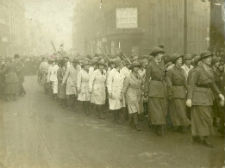On This Day
On This Day, 29 January 1918
On 29, Jan 2018 | In On This Day | By Nicola Gauld
Birmingham Mail
Tuesday 29 January 1918
WOMEN AND THE LAND
INTERESTING STREET SCENES BIRMINGHAM
LORD MAYORS TRIBUTE TO THEIR WORK
In order to stimulate interest in the Women’s Land Movement, and to double, it is hoped, the number of women engaged upon agricultural work, a rally was held in Birmingham to-day of girl workers who had left factories and domestic service for farm employment near Birmingham and in Warwickshire. Three hundred or more of these modern and well-favoured “Hodges” took part, and their presence, from an early hour this morning, their varied and workmanlike costumes, gave an unusual, and not a not unpleasant, appearance to the streets of the city. The change from indoor life in the town to the outdoor life of the country was apparent in their looks and bearing, and a healthier and bonnier lot of the lasses has probably never been seen previously in one body in the city. The girls were entertained to lunch at the Priory Rooms, and at three o’clock they formed a procession in the Old Square to march to the Council House where the Lord Mayor presided over a meeting at which efficiency certificates won by Birmingham and Warwickshire women at the Midland Test last autumn were presented.
Headed by the Police Band, the procession moved out from the Old Square prompt to time; and for an hour it paraded the chief streets, and was almost as popular as the Tank, and certainly more attractive. The route was taken up Bull Street, along Colmore Row, Temple Street West, and Temple Row, down Bull Street, into Corporation Street, up New Street and Paradise Street into Easy Row and Edmund Street, and then across the top of Chamberlain Square, which had reached a few minute before four o’clock. All along the route sightseers were four or five deep. Many of the girls carried implements of their particular trade-rakes, milking stools or pails, hoes, prongs (with the points carefully corked to prevent damage), and pitchforks (along with the dangerous ends innocuous for the time being). The front lot of the girls had a banner, inscribed, “Women’s Land Army,” carried in front of them; a second banner farther down the procession heralded the “Patriotic Seasonal Workers,” and a further banner in the rear exhorted “Grow more wheat to help the Fleet.” Half-a-dozen doyens of women agriculturalists, on account of their age, rode in a big farm wagon, and, in their old-fashioned white caps, were not the least attractive in the estimation of the crowd, and the non-uniformed members- the real professionals in the persons of agricultural labouerers’ wives-looked quite as capable of tackling any and every sort of farm work as their smocked and gaitered younger sisters.
The Council Chamber was filled to overflowing. It was, in fact, a unique assembly in the heart of industrial Birmingham. The Lord Mayor heartily welcomed the girls. When the history of the war came to be written the part that women had played in the national struggle would receive a prominent place. They had done admirably, he said, in new occupations, and, in some instances, for which women were accustomed and unfitted. There were 180 farm girls in Birmingham and Warwickshire, and 1,400 village women who had registered to give part-time for farm work when called upon. The work done was shown by the stripes on the girls’ armlets. One stripe meant 1,440 hours of work, and twenty-four women were wearing six stripes. Seventy out of 80 Warwickshire girls had obtained efficiency tests. They had played their part nobly.
The Hon. Mrs. Alfred Lyttelton addressed the girls, and the Lady Mayoress distributed the certificates.
For further reading on the Women’s Land Army in Birmingham, please refer to the following website:
http://www.womenslandarmy.co.uk/tag/west-midlands/
Natalia Siemens



